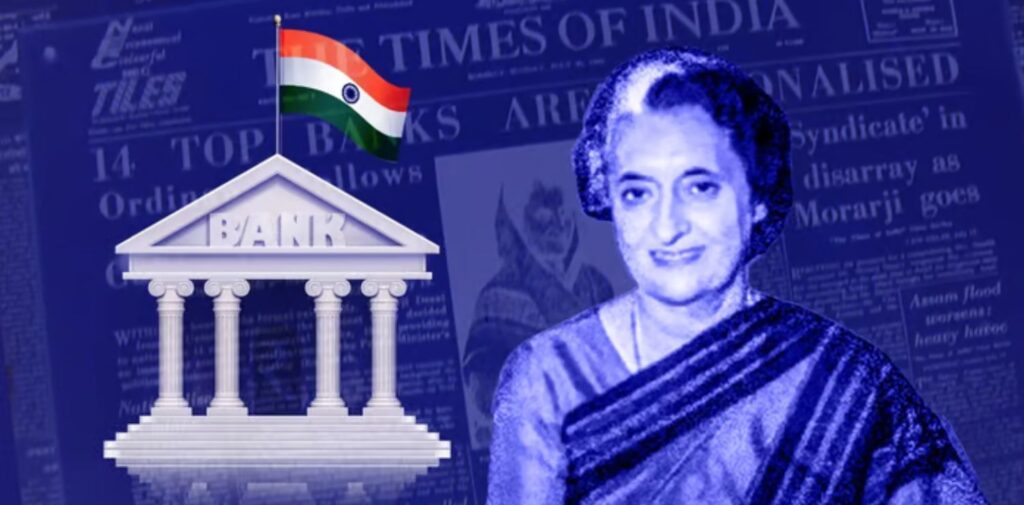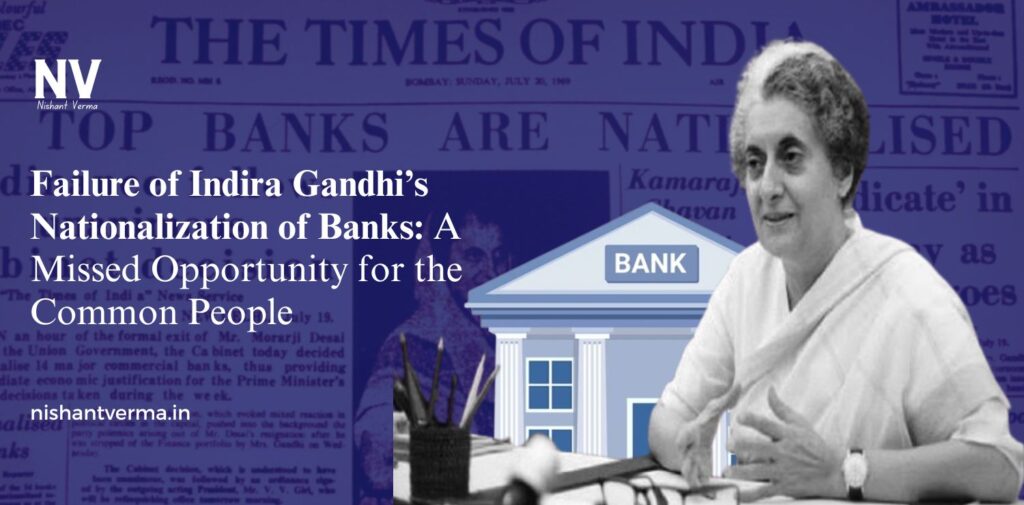In 1969, India saw a significant political and economic shift with the nationalization of 14 major private banks under the leadership of Prime Minister Indira Gandhi. The decision was madae with a vision to extend credit to rural areas, boost economic development, and provide financial access to the masses. However, decades later, it is clear that the nationalization of banks, despite their well-meaning intentions, failed to deliver the promised benefits to the common people. Instead, it became a political tool, hindered by bureaucratic inefficiencies, corruption, and a lack of real reform in the banking system.
The Promise of Nationalization
When Indira Gandhi announced the nationalization of banks, it was to empower the poor and rural population, who were largely neglected by the private banks. At the time, only the rich and urban elite had easy access to credit, while the common farmer or small businessman found it nearly impossible to secure loans. The government’s move was intended to ensure that the banking system would serve national interests, focusing on development and welfare rather than private profit.
By taking over these banks, the government hoped to channel funds into priority sectors such as agriculture, small industries, and infrastructure, areas crucial for India’s growth. The government also envisioned providing financial services to the poor and marginalized, making banking more inclusive.

The Reality of Nationalization
Despite these lofty goals, the nationalization of banks soon became an exercise in bureaucracy and political favouritism rather than a genuine effort to uplift the common people.
Political Interference and Bureaucratic Control
One of the key reasons the nationalization of banks failed was the overwhelming political interference and bureaucratic control that followed. Indira Gandhi’s government filled the banks with political appointees, many of whom had little understanding of banking or financial management. Rather than focusing on merit and expertise, the government turned the banking system into a tool for political gain. Bank managers were often selected based on loyalty to the ruling party, and their focus was on satisfying political demands rather than improving customer service or expanding financial access.
Furthermore, the strict government controls and regulations stifled the growth of these banks. Instead of being able to operate efficiently and make independent financial decisions, the banks had to abide by rules set by the government. This often led to inefficiency, poor customer service, and a reluctance to innovate. The promise of improving access to credit for the common people was overshadowed by a system bogged down in red tape.
Limited Access to Credit for the Poor
Although the nationalization of banks was supposed to bring financial services to the rural and underserved sectors, the reality was quite different. The poor, particularly in rural areas, still struggled to access credit. The nationalized banks were reluctant to lend to small farmers and small-scale businesses without collateral, and many loan officers continued to follow the same practices they did before nationalization, often demanding bribes for services.
Moreover, the focus of these banks remained on the urban elite and large industries, which were seen as more profitable clients. The rural poor, who were supposed to benefit the most from these reforms, continued to face significant barriers in securing loans. The banks became more concerned with meeting government targets rather than focusing on the real needs of the common people.

Inefficiency and Corruption
One of the most glaring issues following the nationalization of banks was the rise of inefficiency and corruption. With the government now controlling the financial institutions, there was little incentive for improvement. The political interference and lack of accountability within the system encouraged corruption at every level of the banking sector. Loan officers and bank managers were often involved in shady dealings, granting loans to those with political connections or taking bribes in exchange for preferential treatment.
This corruption made it nearly impossible for honest, hardworking citizens to access the loans they needed. Small businesses, which were the backbone of India’s economy, found it difficult to expand or grow due to the high levels of red tape and the lack of proper funding. Additionally, the lack of competition among banks, a direct consequence of nationalization, meant there was no drive to improve services or lower interest rates.
Lack of Financial Inclusion
While the nationalization of banks was meant to promote financial inclusion, in reality, it failed to do so effectively. Instead of reaching the poor, the banking system became even more centralized and less accessible to those in need. Bank branches were established in rural areas, but these were often understaffed and poorly managed. Many of the poor still found it difficult to access banking services due to the lack of financial literacy, the need for paperwork, and the absence of trust in the system.
Many people in rural areas prefer to keep their savings in informal financial systems, such as local moneylenders or savings groups, rather than trust the banks. The bank branches, instead of acting as hubs of economic empowerment, became symbols of inefficiency and exclusion.
Stagnation in Banking Services
Another failure of the nationalization was the stagnation in banking services. Private banks, in a competitive environment, are forced to innovate, create new products, and improve customer service. However, after nationalization, public sector banks faced little competition, which meant that they were not incentivized to innovate. As a result, banking services remained stagnant, and the system failed to keep up with the changing needs of the population.
For instance, credit cards, loans for small enterprises, and other financial services were not prioritized. The banking system, instead of evolving to serve the needs of an increasingly modern and globalizing economy, remained focused on outdated procedures and policies.

The Aftermath: A Missed Opportunity
Despite the government’s heavy investment in the banking sector, it’s clear that Indira Gandhi’s nationalization of banks was largely a failure. The promise of widespread financial access for the poor remained unfulfilled, and the banking system continued to cater to the elite and the powerful. The common man, who was supposed to be the primary beneficiary, saw little improvement in their financial situation.
The nationalization of banks also discouraged private-sector banks from entering the Indian market for many years, resulting in a lack of competition and innovation. Even though some reforms have been made in the banking sector since the 1990s, much of the damage done by nationalization remains, and public sector banks continue to be plagued by inefficiency and corruption.
Conclusion: Nationalization of Banks
Indira Gandhi’s decision to nationalize the banks, though well-intentioned, ultimately failed to achieve its primary objective of benefiting the common people. Instead, it created a system where inefficiency, corruption, and political interference took centre stage. While the government claimed it wanted to promote economic development and financial inclusion, the reality was far different. The common people, particularly in rural India, continued to struggle with limited access to credit, poor banking services, and a lack of financial inclusion. Nationalization of banks, as it turned out, was not the silver bullet for India’s economic woes.




